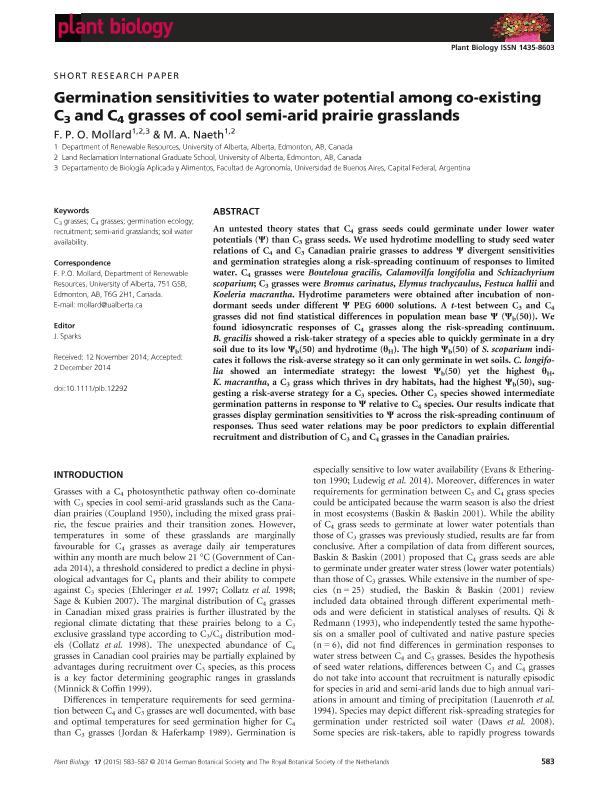Mostrar el registro sencillo del ítem
dc.contributor.author
Mollard, Federico Pedro Otto

dc.contributor.author
Naeth, M. A.
dc.date.available
2017-06-02T21:29:33Z
dc.date.issued
2015-03
dc.identifier.citation
Mollard, Federico Pedro Otto; Naeth, M. A.; Germination sensitivities to water potential among co-existing C3 and C4 grasses of cool semi-arid prairie grasslands; Wiley; Plant Biology; 17; 2; 3-2015; 583-587
dc.identifier.issn
1435-8603
dc.identifier.uri
http://hdl.handle.net/11336/17451
dc.description.abstract
An untested theory states that C4 grass seeds could germinate under lower water potentials (Ψ) than C3 seeds. We used hydrotime modelling to study seed water relations of C4 and C3 Canadian prairies grasses to address both Ψ divergent sensitivities and germination strategies along a risk-spreading continuum of responses to limited water. C4 grasses were Bouteloua gracilis, Calamovilfa longifolia and Schizachyrium scoparium; C3 grasses were Bromus carinatus, Elymus trachycaulus, Festuca hallii and Koeleria macrantha. Hydrotime parameters were obtained after incubation of non-dormant seeds under different Ψ PEG 6000 solutions. A t-test between C3 and C4 grasses did not find statistical differences in population mean base Ψ (Ψb(50)). We found idiosyncratic responses of C4 grasses along the risk-spreading continuum. B. gracilis showed a risk-takers strategy of a species able to quickly germinate in a dry soil due to its low Ψb(50) and hydrotime (θH). The high Ψb(50) of S. scoparium indicates it follows the risk-averse strategy so it can only germinate in wet soils. C. longifolia showed an intermediate strategy: the lowest Ψb(50) yet the highest θH. K. macrantha which thrives in the driest habitats showed the highest Ψb(50) suggesting a risk-averse strategy for a C3 species. Other C3 species showed intermediate germination patterns in response to Ψ relative to C4 species. Our results indicate that grasses display germination sensitivities to Ψ across the risk-spreading continuum of responses. Then seed water relations may be poor predictors to explain C3-C4 grasses differential recruitment and distribution in the Canadian prairies.
dc.format
application/pdf
dc.language.iso
eng
dc.publisher
Wiley

dc.rights
info:eu-repo/semantics/openAccess
dc.rights.uri
https://creativecommons.org/licenses/by-nc-sa/2.5/ar/
dc.subject
C3 Grasses
dc.subject
C4 Grasses
dc.subject
Germination Ecology
dc.subject
Recruitment
dc.subject
Semi-Arid Grasslands
dc.subject
Soil Water Availability
dc.subject.classification
Otras Ciencias Biológicas

dc.subject.classification
Ciencias Biológicas

dc.subject.classification
CIENCIAS NATURALES Y EXACTAS

dc.title
Germination sensitivities to water potential among co-existing C3 and C4 grasses of cool semi-arid prairie grasslands
dc.type
info:eu-repo/semantics/article
dc.type
info:ar-repo/semantics/artículo
dc.type
info:eu-repo/semantics/publishedVersion
dc.date.updated
2017-06-02T17:32:44Z
dc.journal.volume
17
dc.journal.number
2
dc.journal.pagination
583-587
dc.journal.pais
Estados Unidos

dc.journal.ciudad
Hoboken
dc.description.fil
Fil: Mollard, Federico Pedro Otto. University of Alberta; Canadá. Universidad de Buenos Aires. Facultad de Agronomia. Departamento de Biología Aplicada y Alimentos; Argentina. Consejo Nacional de Investigaciones Científicas y Técnicas; Argentina
dc.description.fil
Fil: Naeth, M. A.. University of Alberta; Canadá
dc.journal.title
Plant Biology

dc.relation.alternativeid
info:eu-repo/semantics/altIdentifier/doi/http://dx.doi.org/10.1111/plb.12292
dc.relation.alternativeid
info:eu-repo/semantics/altIdentifier/url/http://onlinelibrary.wiley.com/doi/10.1111/plb.12292/abstract
Archivos asociados
